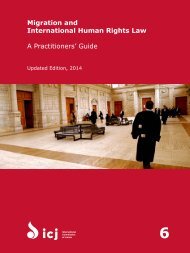You also want an ePaper? Increase the reach of your titles
YUMPU automatically turns print PDFs into web optimized ePapers that Google loves.
EASO Country of Origin Information report — South and Central <strong>Somalia</strong> — Country overview — 21<br />
Several minority groups with different backgrounds do not belong to the ‘noble’ majority clans. These are the ethnic<br />
and religious minorities and the occupational groups. The ethnic and religious minorities generally have a different<br />
origin and, in some cases, even their own languages. The biggest groups are Bantu (Jareer), Benadiri, Sheikhal and<br />
Ashraf. The Bantu are farmers living in the fertile valleys of the south. Part of this group has supposedly been living in<br />
this area before the Somali populated the region; others were brought as workers in pre‐colonial times as well as by<br />
the Italian colonialists. ‘Benadiri’ is a common denomination for several unrelated urban minorities living in coastal<br />
towns such as Merka, Baraawe and Mogadishu; they are an ethnic mix of Somalis and several seafaring people such<br />
as Arabs, Indians or Portuguese ( 67 ).<br />
The occupational groups do not differ culturally and linguistically from the majority clans, but due to practices and<br />
occupations perceived as un‐Islamic, they are considered impure. Usually denominated Waable, Sab, Midgaan or<br />
Madhibaan, and contrary to the majority clans, they cannot trace their ancestry back to the Prophet Mohammed ( 68 ).<br />
For more information on clans and ethnic groups, see section 2.<br />
1.2.3 Languages and spelling<br />
1.2.3.1 Languages<br />
Unlike many other African countries, the linguistic situation of <strong>Somalia</strong> is relatively homogeneous. <strong>Somalia</strong>’s official<br />
language is Somali and it is the unchallenged medium all over the country ( 69 ). For most speakers in <strong>Somalia</strong>, Somali<br />
is the native and only language. Somali is also spoken as a native language and as a second language by millions of<br />
people in eastern Ethiopia (Ogaden region), north‐eastern Kenya and south‐eastern Djibouti, i.e. in areas bordering<br />
<strong>Somalia</strong> ( 70 ).<br />
In 1972, the Somali language was standardised ( 71 ). A variety of north‐eastern Somali is promoted as the standard<br />
variety. However, speaking the standard (north‐eastern) variety is not the norm throughout the country. Most of<br />
those who speak Somali do so in their regional dialect, or will at least have a regional slant in their Somali. There is<br />
a broad distinction between northern and southern varieties, with the border running roughly across the Mudug<br />
region ( 72 ). Somali is one of the best documented African languages ( 73 ). The broad distinction between northern and<br />
southern Somali is well documented and can generally be established through language analysis. Finer distinctions<br />
within this broad distinction are possible ( 74 ).<br />
Somalis themselves often make a distinction between Maxaa‐tiri and Maay‐tiri. Maay‐tiri refers to regional dialects<br />
spoken in the southern regions Bay, Bakool, Gedo, Middle Jubba and Lower Shabelle. Maxaa‐Tiri is best described<br />
as a broadly understood variety, a collection of regional varieties that are mutually intelligible ( 75 ).<br />
( 67 ) Minority Rights Group International, No redress: <strong>Somalia</strong>’s forgotten minorities, 31 January 2010 (http://www.minorityrights.<br />
org/lid=10370) accessed 10 June 2014, p. 8-12; BAMF, Minderheiten in <strong>Somalia</strong>, July 2010 (https://milo.bamf.de/milop/livelink.exe/fet<br />
ch/2000/702450/683266/693991/697672/697677/6029534/13604856/13565580/Deutschland___Bundesamt_f%C3%BCr_Migration_und_<br />
Fl%C3%BCchtlinge,_Minderheiten_in_<strong>Somalia</strong>,_Juli_2010.pdfnodeid=13904432&vernum=-2) accessed 10 June 2014, p. 4-16; DIS, <strong>Report</strong> on Minority Groups<br />
in <strong>Somalia</strong>, 17-24 September 2000 (http://www.unhcr.org/cgi‐bin/texis/vtx/refworld/rwmain/opendocpdf.pdfdocid=3ae6a5fa0) accessed 10 June 2014,<br />
p. 19-50.<br />
( 68 ) Tiwald, A., Die Parias <strong>Somalia</strong>s: Ständische Berufskasten als Basis sozialer Diskriminierung, Österreichischer Integrationsfonds, December 2010 (http://www.<br />
integrationsfonds.at/laenderinformation/diepariassomalias) accessed 10 June 2014; BAMF, Minderheiten in <strong>Somalia</strong>, July 2010 (https://milo.bamf.de/milop/<br />
livelink.exe/fetch/2000/702450/683266/693991/697672/697677/6029534/13604856/13565580/Deutschland___Bundesamt_f%C3%BCr_Migration_und_<br />
Fl%C3%BCchtlinge,_Minderheiten_in_<strong>Somalia</strong>,_Juli_2010.pdfnodeid=13904432&vernum=-2) accessed 10 June 2014, p. 16-21; Minority Rights Group<br />
International, No redress: <strong>Somalia</strong>’s forgotten minorities, 31 January 2010 (http://www.minorityrights.org/lid=10370) accessed 10 June 2014, p. 12; DIS: <strong>Report</strong><br />
on Minority Groups in <strong>Somalia</strong>, 17-24 September 2000 (http://www.unhcr.org/cgi‐bin/texis/vtx/refworld/rwmain/opendocpdf.pdfdocid=3ae6a5fa0) accessed<br />
10 June 2014, p. 49-53; ACCORD, Clans in <strong>Somalia</strong>. <strong>Report</strong> on a Lecture by Joakim Gundel, December 2009 (http://www.ecoi.net/file_upload/90_1261130976_<br />
accord‐report‐clans‐in‐somalia‐revised‐edition-20091215.pdf) accessed 10 June 2014, p. 15-16.<br />
( 69 ) Lamberti, M., Map of Somali dialects in the Somali Democratic Republic. With suppl: Speech variation in <strong>Somalia</strong>, Helmut Buske Verlag, Hamburg, 1986, p. 13.<br />
( 70 ) Lewis, M., Paul, G., Simons, F. and Fennig, C.D. (eds.), Ethnologue: Languages of the World, Seventeenth edition, SIL International, Dallas, 2014, p. 184. Online<br />
version: (http://www.ethnologue.com)<br />
( 71 ) Puglielli, A., ‘Somali Phonology’, Phonologies of Asia and Africa, Volume 1, Kaye, A.S. & Lake, W. (eds.), Eisenbrauns, US, 1997.<br />
( 72 ) Lamberti, M., Die Somali‐Dialekte, Helmut Buske Verlag, Hamburg, 1986, p. 25-30.<br />
( 73 ) Puglielli, A., ‘Somali Phonology’, Phonologies of Asia and Africa, Volume 1, Kaye, A.S. & Lake, W. (eds.), Eisenbrauns, US, 1997.<br />
( 74 ) Lamberti, M., Die Somali‐Dialekte, Helmut Buske Verlag, Hamburg, 1986, p. 25-30.<br />
( 75 ) Tosco, M., ‘The unity and diversity of Somali dialectal variants’, The harmonization and standardization of Kenyan languages: Orthography and other aspects,<br />
no. 87 of book series, Ogechi, N.O., Ngala Oduor, J.A. & Iribemwangi, P.I. (eds.), Centre for Advanced Studies of African Society, Kenya, 2012.



